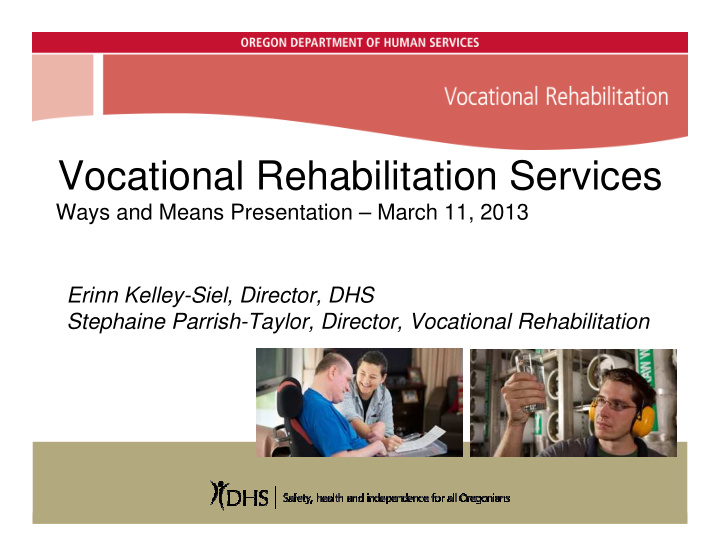



Vocational Rehabilitation Services Ways and Means Presentation – March 11, 2013 Erinn Kelley-Siel, Director, DHS Stephaine Parrish-Taylor, Director, Vocational Rehabilitation
Presentation Outline • Why Vocational Rehabilitation matters • Vocational Rehabilitation process • Who we serve • Centers for Independent Living (CIL) • Outcomes • Breakthroughs • Budget • Vocational Rehabilitation Summary �
Vocational Rehabilitation Mission Statement Assist Oregonians with disabilities to achieve and maintain employment and independence �
Why Vocational Rehabilitation Matters • 279,001 working-age Oregonians experience a disability • Only 34.1% of individuals with disabilities work vs. 71% of individuals without disabilities • $16,047 is the median wage for an individual with a disability; median wage for non-disabled individuals is $26,668 • 9,310 youth exited special education last year 2,032 Oregonians went to work in FFY 12 because of Vocational Rehabilitation services �
Services, Process and Client Overview
Services • Rehabilitation • Youth Transition • Supported Employment • Independent Living �
Caseload � �
Process • Application • Eligibility determination: Obtain and review medical records; secure need evaluations; identify barriers • Plan: Establish plan goal; identify and authorize services; monitor progress • Job search and placement: Authorize employment services: job preparation; development; coaching • Placement: Monitor performance for 90 days • Closure: 90 days of successful employment • Post-Employment: Job retention services �
Service Continuum �
Client Disability Demographics ��
Client Cognitive Impairments ��
Client Gender, Age and Ethnicity Frequency Percent Gender 8,447 56 Male 6,765 44 Female 15,212 100 Total Age Frequency Percent 1,596 10 Under 20 3,141 21 20 to 29 2,587 17 30 to 39 3,449 23 40 to 49 3,490 23 50 to 59 956 6 60 Plus 15,219 100 Total Ethnicity Only* Frequency Percent American Indian or Alaskan Native 602 4 Black 753 5 Asian 249 2 Hispanic or Latino 1,066 7 Native Hawaiian or other Pacific Islander 136 1 13,522 83 White Total 16,328* 100 Total exceeds number of clients due to clients reporting more than one ethnicity. • Source: Queries from ORCA 2 database ��
Centers for Independent Living (CIL)
Centers for Independent Living (CIL) ��
CIL Clients by Disability Category ��
CIL Clients by Age ��
CIL Program Performance 2008 2009 2010 2011 2012 Documented Information 8,027 7,875 9,312 13,928 16,925 & Referral Services Comprehensive Services 2,210 1,861 1,954 2,065 2,133 Provided Percent of Consumer Goals 55% 62% 60% 60% 61% Achieved Percent of Satisfied 88% 92% 89% 87% 90% Consumers An informal study of program outcomes from only 3% of the Independent Living Program’s 2010 consumers showed state cost savings & increased tax revenue equal to approximately 810% of Oregon’s program investment for the year ��
Outcomes
Client Outcomes Meet Jose… Living life “full speed ahead” with the help of VR • Cancer survivor • Functionally limited • Bicycle commuter • Gainfully employed ��
Employment Outcomes Year FFY 2008 FFY 2009 FFY 2010 FFY 2011 FFY 2012 Employment 2,604 1,928 1,176 1,793 1,334 Outcomes Supported n/a 138 131 185 228 Employment Outcomes YTP 571 365 237 404 470 Rehab Rate* 63 % 55% 47% 57% 57% *Percentage of clients closed from plan with a rehabilitation ��
VR Services Make A Difference �� ��
Services for Employers • Consultations to help employers diversity their workforces •Job Fairs •Pre-screening of applicants •Diversity and inclusion information •Disability awareness •Americans with Disabilities Act ��
Return on Investment For every $1 invested in VR, there is a $5.20 savings for taxpayers over the life of a client For every General Fund dollar invested, the State saves $24 over the life of a client Study conducted by Jeff Renfro and Dr. Tom Potiowsky Northwest Center for Economic Research Portland State University – See Appendix ��
Accomplishments 30% increase in employment outcomes for clients 10% decrease in cost per outcome • Performance-based job • Performance Audit development contracts – Comprehensive policy manual revision completed – Required agency-provided job development training – Enhanced use of performance data – Established minimum qualifications – Reduction in cost per case – Shifted from fee-for-service – Increased feedback to to benchmark payments counselors – Fixed fees for job preparation ��
Cost Drivers • Resolution of USDOJ findings regarding employment services for individuals with intellectual and developmental disabilities • Complex needs of clients • Inflationary costs of goods and services ��
Breakthroughs • Systems Change • Collaborations – Performance-Based Job – Youth Transition Program Development (YTP) – Office of Developmental • Youth Transition 2.0 Disability Services • YTP + – Closing the Employment Gap – Work Incentive Network • Employer Engagement – OVRS Staffing Solutions – Think Beyond the Label – National Employer Team ��
Budget Overview
OVRS Budget: $83.39 Million Total Funds ������������ ���� �������� ����� ������ ���� ����� �������� �������� �� ����!� �����# ������� �"���� �"��� ��$� ��
Budget: By Fund Type – 77% Federal Funds General Fund $16.45 20% Other Fund $2.32 Federal 3% Fund $64.63 77% ��
Budget: 94% in Direct Payment and Service Delivery Direct Client Services $37.79 45% Program Design $5.19 Direct 6% Payments to Clients/ Providers $40.41 49% ��
Vocational Rehabilitation Summary • It’s part of the State’s workforce system that meets the needs of a complex population • It builds on and extends upon the work of other state programs in and out of DHS • It leverages resources • It creates innovative programs that can serve as models for other programs • Research demonstrates it’s a good investment ��
Wrap Up DHS Presentations: • March 13 – Self Sufficiency Programs • March 14 – Developmental Disability Programs Questions regarding Vocational Rehabilitation? Thank you! ��
Recommend
More recommend